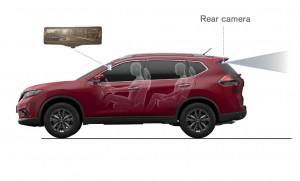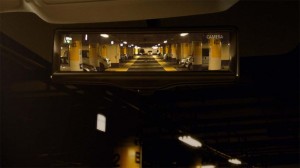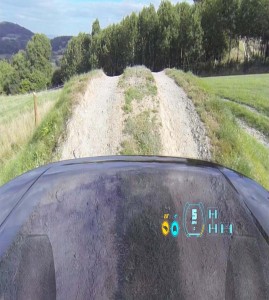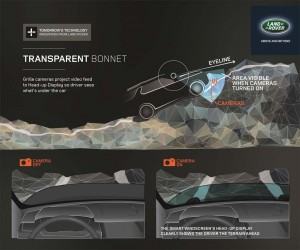It’s always a challenge for a motorist to be sure they can see everything going on around their vehicle, whether backing out of a parking spot or changing lanes. But new technologies have begun to make that challenge a little easier and safer, with two intriguing new features making their debut at the New York Auto Show later that week.
That includes a new “smart rearview mirror” developed by Nissan, as well as a feature Land Rover is dubbing the “Transparent Hood.”
“Smart Rearview Mirror will give our customers the best possible view no matter how tall the passengers in the back seat or how bad the road conditions,” said Andy Palmer, Chief Planning Officer and Executive Vice President of Nissan.
The prototype technology, making its debut on a 2014 Nissan Rogue at New York’s Jacob Javits Center allows a driver to transform the conventional rearview mirror into an LCD monitor, overcoming several problems – for one thing, the challenge of seeing around the heads of people in the back seat and a pile of cargo in a hatchback like the Rogue. It also improves visibility at night, especially in bad weather.
It’s an alternative take on the rearview camera technology that is becoming increasingly popular – and which the National Highway Traffic Safety Administration plans to require on all vehicles by 2018.
(For more on plans to use sideview cameras, Click Here.)
It also hints at the growing industry interest in replacing mirrors entirely with cameras that can automatically adapt to different lighting and weather conditions and make it easier to see into a vehicle’s blind spots.
As TheDetroitBureau.com reported earlier this month, the Alliance of Automobile Manufacturers, a consortium that includes VW, Toyota and General Motors – as well as start-up Tesla Motors – has petitioned the NHTSA to begin permitting manufacturers to replace sideview mirrors with digital cameras.
That technology has long been a favorite with automotive designers and has the promise of reducing both wind noise and full-guzzling aerodynamic drag. But it will require a waiver by federal regulators to permit the use of sideview mirrors.
It’s not clear if Nissan would require similar approval, though several makers have already begun using a similar, if less capable technology. Some rearview mirrors now contain a very small LCD display hidden under the reflective glass. When the vehicle is shifted into reverse, the monitor displays an image from a backup camera – an alternative to using a larger display on the instrument panel.
Nissan hasn’t said whether it has specific production plans for the smart mirror but will put it to use in the ZEOD RC, race car prototype that it will be campaigning in this year’s grueling endurance race, the 24 Hours of Le Mans.
(New study shows motorists worried about security of connected vehicles. Click Here for more.)
Land Rover also has yet to say if it will go to production with its Transparent Hood, a virtual imaging technology that could prove useful both to off-roaders as well as those maneuvering tight spaces on urban roadways.
The system is debuting on the Land Rover Discovery Vision Concept, and it uses cameras mounted in the grille to look at the terrain immediately ahead of the vehicle. The image is then projected onto a full-width heads-up display at the bottom of the windshield. A driver looking ahead would get a seeming x-ray image of potholes, rocks or other obstacles such as concrete barriers in a parking lot.
The idea is “to give drivers an augmented view of reality to help them tackle anything from the toughest off-road route to the tight confines of urban parking,” explains Dr. Wolfgang Epple, Director of Research and Technology for Jaguar Land Rover.
With digital camera technology becoming both more capable and less expensive, manufacturers are starting to find more ways to put it to use. Nissan’s Around View monitor provides a virtual birds-eye image of the area surrounding a vehicle – a concept several other makers are now adopting. Honda recently introduced a camera-based system to watch the blind spot on the passenger side of its Accord model. And Tesla is one of several makers that would like to replace sideview mirrors with cameras – in this case on the upcoming Model X battery SUV.
Cameras also are used to support a variety of other functions, such as the EyeSight system on various Subaru models which provides lane departure warnings and forward collision alerts. The latest Mercedes-Benz S-Class uses cameras to provide an infrared view of the road at night. It’s camera-based “Magic” suspension system also can spot potholes and bumps in the road, all but instantly adjusting the settings to smooth out the vehicle’s ride.




